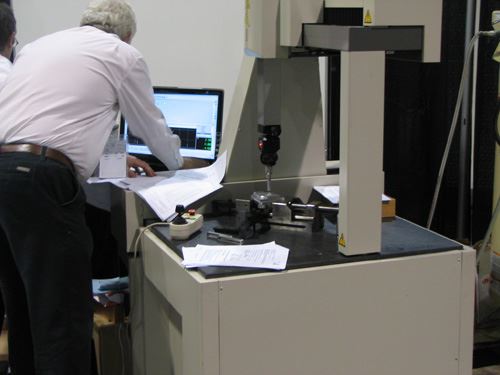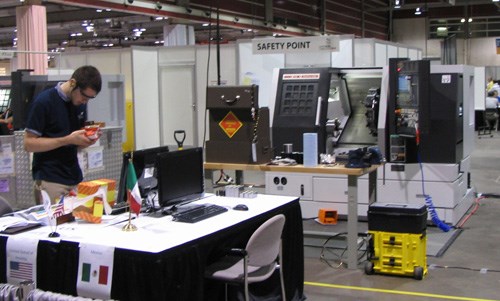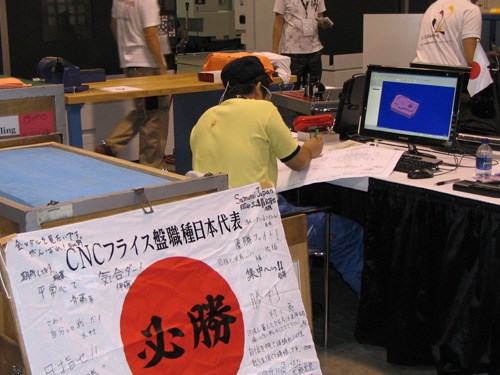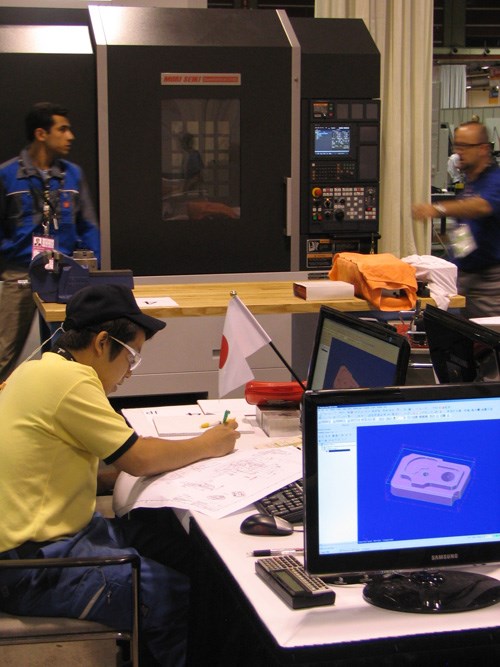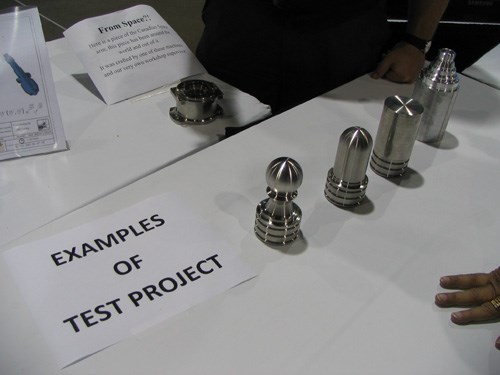Leadership Skills Also Characterize A Champion
The WorldSkills Competition is a biennial event in which students compete with their international peers in occupational trades. This year, the team from the United States entered in both the CNC turning and CNC milling categories. Includes VIDEO.
Share


This video shows highlights from the CNC machining contests along with scenes from the 2009 WorldSkills Competition in Calgary, Alberta
Competing in the WorldSkills Competition (WSC) is literally the chance of a lifetime. Even observing it might be a once-in-a-lifetime opportunity. The 2009 WSC took place September 1-7 in Calgary, Alberta, although this biennial event changes locations every two years. As one event director explained, it is not likely to return to North America “in our lifetime,” so I am glad I was able to attend as a guest of Mori Seiki. This machine tool builder provided more than two dozen machine tools for the CNC machining contests—my main interest.
At the WSC, students in occupational trades compete with their peers from other countries. This year, 51 countries were represented, including industrial powerhouses such as Japan, Germany, Taiwan and Switzerland as well as countries still developing as commercial/industrial economies such as Saudi Arabia, Tanganyika and Indonesia. The occupational skill areas in which students compete range from cooking, hairdressing and plumbing to welding, mechatronics, CNC turning and CNC milling. More than 1,000 students took part in the competition. The U.S. “WorldTeam” consisted of 16 individuals, all in their teens or early twenties, who have earned membership by winning national contests and subsequent qualifying trials under the SkillsUSA program. SkillsUSA, formerly known as VICA—the Vocational Industrial Clubs of America, is the official organization representing the United States.
Only 20 students from around the world were eligible to compete in each of the CNC Turning and CNC Milling categories. The U.S. team entered contestant in both categories. Josef Schwarzer, a student at Romeo Engineering and Technology Center in Washington, Michigan, competed in CNC Turning. Fernando DeLaGarza, a student at the Dehryl A. Dennis Technical Education Center in Boise, Idaho, competed in CNC Milling. Students in these events were given a blueprint of a complex turned or milled part and were required to produce the part to spec in a limited time period. All of the contestants work with the same CNC programming system and identical CNC machine tools, but each student is responsible for bringing his or her own tool chest.
So how did the U.S. competitors do in these contests? In CNC Turning, Mr. Schwarzer finished 16th. (A student from Thailand won the gold medal.) In CNC Milling, Mr. DeLaGarza finished 17th. (A student from Korea won the gold medal.)
At first glance, the U.S. showing in these machining areas may not seem very encouraging. However, these results don’t tell the whole story. Proficiency in a technical skill, whether in CNC machining or in any high-tech occupation, is just part of the picture. Other traits and abilities are also essential to succeed as a professional in manufacturing, especially when competitiveness in a global economy is the real issue. In this context, the machining contestants from the United States may well have the edge after all.
I had a long discussion about this with Mark Claypool, team leader for the SkillsUSA WorldTeam. He pointed out that SkillsUSA’s focus with its student members goes beyond the technical skills. It also emphasizes the “soft” skills, what he calls the “professional development” side of things. These include communications, working as a team, leadership—the kinds of things that employers look for in addition to technical capability. “That's what sets our students apart from the rest of the world,” Mr. Claypool told me.
He said there was a wonderful example of this distinction in CNC Turning during the week in Calgary. On the last day of the competition, the technical experts who were running the CNC Turning contest split the 20 national competitors into two groups of 10. These groups had to work together as a team to make pieces for a chess board. Although this team contest was not an officially sanctioned part of the WorldSkills competition, it was a way for the competitors to experience another dimension to skills preparedness.
The Japanese competitor, who finished with the bronze medal, led one team. Mr. Schwarzer, the U.S. competitor, was chosen to lead the other team. Mr. Claypool told me that Mr. Schwarzer immediately used what he learned as a SkillsUSA member to take charge, lead, delegate, put a plan together and inspire his team to victory. “The Japanese competitor may have been better on the machine than Mr. Schwarzer, but he struggled greatly with leading his team. He floundered, and when the pressure was on, he simply wasn’t prepared to take charge and make things happen as a team,” Mr. Claypool said. He believes that this student was trained to excel as an individual competitor—to be technically proficient, to win when it was up to “him and the machine.” Mr. Claypool contends that a broader approach to workplace preparation is more important. “In the real world of work, where teams are a way of life, I’d take Josef any day,” Mr. Claypool concluded.
Mr. Claypool made another point. He suggested that one shouldn’t use the official contest results to make any broad inferences about the workforces of the countries represented by the winning competitors, or about the level of their technical student training systems. He reminded me that many of the other nations have been preparing for the Calgary WorldSkills competition for years. “They chose their competitors for the 2009 event 5 to 10 years ago and have been training them just for this purpose,” he said. Many are likely to be on government payrolls during that time. “They aren't working in a business or going to school, as our competitors do, fitting training in when and where they can. So when we evaluate how our competitors do in this competition, the best barometer to compare against is how we've done in the past and how we compete against other countries that do not have the kind of governmental support and involvement that some of the medal-winning countries do,” he told me. He also added that, as good as some of the other nations “appear” to be, “what we see in this contest is not indicative of their entire workforce. Our team members would compete very well against a similarly prepared worker in these other countries. We compete against that special exception rather than the rule.”
From my own experience as an observer of the competition, I found watching the SkillsUSA WorldTeam machining contestants very gratifying. Both U.S. students in the CNC machining contests showed the intense concentration and “hustle” expected at this level of competition. Although neither medaled in their category, the outcome was still a validation of their choice to pursue a career in manufacturing. For me, it was a validation of the importance of skills training and the need to attract more talented young people to metalworking. The event also highlighted the need to make such training a higher national priority. Unlike teams from nearly all other countries, the U.S. team gets no support from the federal government—the team is dependent on corporate and private sponsors to pay for training, travel costs and other expenses.
Related Content
Finding the Right Tools for a Turning Shop
Xcelicut is a startup shop that has grown thanks to the right machines, cutting tools, grants and other resources.
Read MoreInside Machineosaurus: Unique Job Shop with Dinosaur-Named CNC Machines, Four-Day Workweek & High-Precision Machining
Take a tour of Machineosaurus, a Massachusetts machine shop where every CNC machine is named after a dinosaur!
Read MoreShop Tour Video: You've Never Seen a Manufacturing Facility Like This
Explore Marathon Precision’s multi-process approach to manufacturing, where blacksmiths and hand-forged dies meet state-of-the-art CNC machining. Discover how restoring classic muscle cars and building custom art projects creates a dynamic shop culture — and draws top talent to this unique and innovative metalworking facility.
Read MoreHow I Made It: Amy Skrzypczak, CNC Machinist, Westminster Tool
At just 28 years old, Amy Skrzypczak is already logging her ninth year as a CNC machinist. While during high school Skrzypczak may not have guessed that she’d soon be running an electrical discharge machining (EDM) department, after attending her local community college she found a home among the “misfits” at Westminster Tool. Today, she oversees the company’s wire EDM operations and feels grateful to have avoided more well-worn career paths.
Read MoreRead Next
OEM Tour Video: Lean Manufacturing for Measurement and Metrology
How can a facility that requires manual work for some long-standing parts be made more efficient? Join us as we look inside The L. S. Starrett Company’s headquarters in Athol, Massachusetts, and see how this long-established OEM is updating its processes.
Read More

